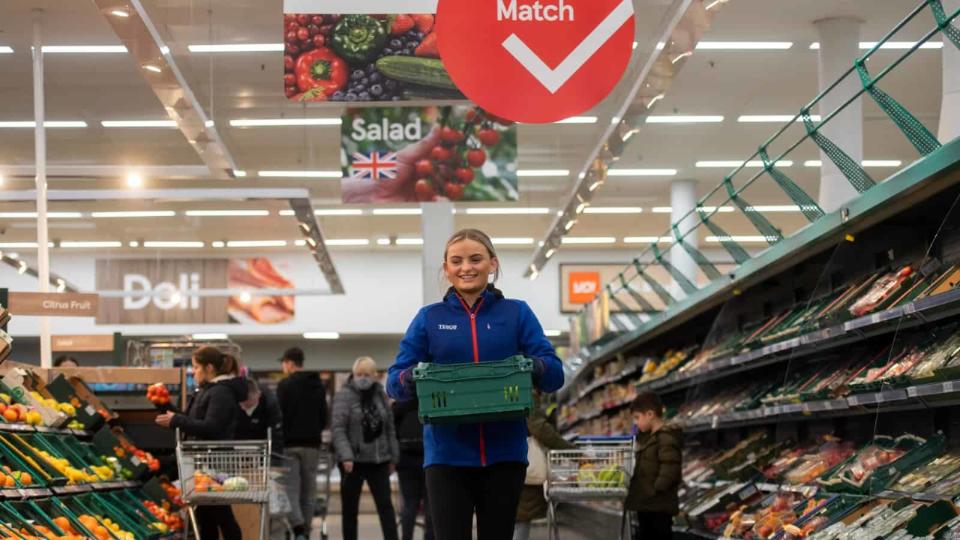Up 6.3%, where will the Tesco share price go next?

The Tesco (LSE:TSCO) share price has broadly performed in line with the FTSE 100 over the past 12 months. It’s up 6.3% over the period, while the blue-chip index is up 5.9%. However, the big question is, where will it go next?
Holding market share
UK shoppers collectively saved £1.3bn on supermarket deals over a four-week period in March and April. This coincided with a 14th consecutive monthly fall in food inflation which, according to Kantar Worldpanel, had fallen to 3.2% during the same period.
Grocers were also feeling the pressure to respond to customers’ desire for deals. According to Kantar, 29.3% of supermarket sales came from promotional spending — the highest level outside of Christmas since June 2021.
Britain’s largest grocers appear to be the beneficiaries of this trend, with Tesco and Sainsbury’s increasing their market shares by 0.4% over 12 weeks. Tesco currently holds 27.6% of the UK’s grocery market. That’s 12% ahead of Sainsbury’s — the UK’s second-largest grocer.
Market share data provides both positive and negative indicators for Tesco. It hasn’t lost much, if any, market share since low-cost Aldi and Lidl entered the UK market. However, Tesco isn’t as dominant as it once was in the sector. When Kantar records began in 2011, the supermarket chain had more than 30% of the market.
Solid performance
Tesco’s financial results for the year ending 24 February were impressive. Sales grew significantly, with group sales excluding VAT and fuel rising 7.2% to £61.48bn. Overall sales, including fuel (which has seen some deflationary pressure over the period), reached £68.19bn, reflecting a 4.2% increase. The company attributed this performance to its strong market share and growing customer traffic.
Benefitting from premiumisation
While inflation remains an issue for many people, Tesco indicated that more people are “eating in and entertaining in and then treating yourself”. It also appears likely that as the cost-of-living crisis fades, shoppers will return to more premium shopping destinations. We may not think of Tesco as premium, but it’s certainly more premium than Aldi and Lidl.
Outstanding value?
I’ve been fairly bullish on Tesco for some time, but never found an attractive entry point. However, I’m no longer convinced it’s the best value in the sector. Instead, my attention is moving towards Marks and Spencer.
Below, I’ve compared earnings per share (EPS) forecasts for the three main listed grocers, and I’ve provided the respective price-to-earnings (P/E) ratios for those years. As we can see, Marks and Spencer appears to come out on top, with lower P/E ratios and a stronger net debt position than its peers.
There’s a caveat, of course. Tesco has a dividend yield around 4%, Sainsbury’s 5%, and M&S, just 0.4%.
Tesco | EPS | P/E | M&S | EPS | P/E | Sainsbury’s | EPS | P/E | |
2024 | 23.9 | 12.4 | 23.9 | 10.7 | 16 | 16.5 | |||
2025 | 25.4 | 11.7 | 25.2 | 10.2 | 20.5 | 12.9 | |||
2026 | 26.6 | 11.2 | 27 | 9.5 | 21.8 | 12.2 | |||
Net debt | £10.1bn | £2.4bn | £5.5bn |
I certainly don’t see Tesco as a bad investment opportunity. It’s just not outstanding in its sector. It’s trading with attractive metrics, it’s benefitting from shifting market forces, and it has a dominant position in the market. Economies of scale are very useful in the grocery sector.
So where will it go next? I’m not sure it’ll push on much further unless its earnings figures really surprise us.
The post Up 6.3%, where will the Tesco share price go next? appeared first on The Motley Fool UK.
More reading
James Fox has no position in any of the shares mentioned. The Motley Fool UK has recommended J Sainsbury Plc and Tesco Plc. Views expressed on the companies mentioned in this article are those of the writer and therefore may differ from the official recommendations we make in our subscription services such as Share Advisor, Hidden Winners and Pro. Here at The Motley Fool we believe that considering a diverse range of insights makes us better investors.
Motley Fool UK 2024

 Yahoo Finance
Yahoo Finance 